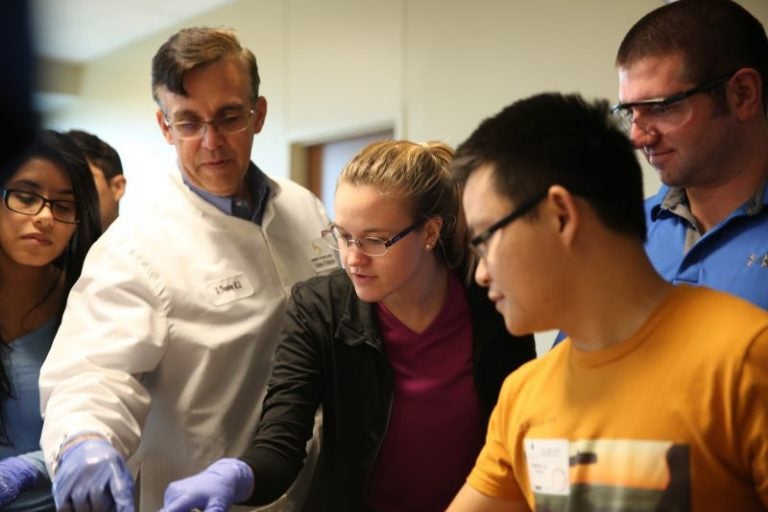Inspired by her little brother who has two cochlear implants to aid his hearing and an insulin pump to treat his diabetes, Christine Sleppy wants to combine her engineering skills with medicine to help change lives.
“Growing up, I saw how that sort of technology changed his life as well our whole family and made it possible for him to live like a normal person,” Sleppy said. “So I want to use my engineering skills toward the medical field to be able to impact other people’s lives the way it impacted my family.”
Sleppy is among 15 UCF engineering students who are getting to know the inner workings of one of the most intricately designs machines – the human body.
Thanks to a partnership between UCF’s College of Engineering and Computer Science and the College of Medicine, the first cohort of students in UCF’s new biomedical engineering (BME) master’s program are receiving a tactile introduction to the human anatomy.
The master’s program trains young engineers to design medical devices for implant within or on the body, such as heart pumps, pacemakers, and prosthetics. Most of the students have not had any real exposure to anatomy. So the College of Medicine’s Mechanics of Biostructures class is designed to give them a better understanding of the body’s structures.
College of Medicine faculty members Drs. Mohtashem Samsam and Robert Steward lecture the students on basic anatomy. Then the students have seven four-hour lab sessions with Dr. Daniel Topping, assistant professor of family medicine and anatomy. In the lab, the future biomedical engineers examine the musculoskeletal structure of cadavers – persons who have donated their bodies to help train medical students.
“We take them through various body systems including the lungs and chest cavity, spine and back, and the upper and lower extremities,” explained Topping. “The lab runs concurrently with the anatomy class for our first-year medical students and so the students are not required to do dissections as much of the work has already been done by the medical students. But they are able to touch and feel and we pay special attention to cadavers that are found to have medical devices or prosthetics. We’ve had donors with breast implants, hip replacements and a pacemaker.”
“It really humanizes the experiences when you’re seeing the body intact and as a whole system rather than just parts,” said student Katherine McGrane. “We learn so much from physically seeing and touching these innermost components that we’re used to seeing only in drawings. This give us a lot more insight on how we will go forward and design better medical implants and treatments.”
Program director and UCF engineering professor, Dr. Alain Kassab said the collaboration provides an indispensable experience for the future biomedical engineers.
“For students that are working on cardiovascular flow, for example, it’s the first time they have seen what an aorta looks like in terms of the structure, the lumen and the actual geometry of these vessels,” he said. “So this will make them better modelers and better at providing solutions for medical problems.”
Kassab said he is motivated by the feedback he has received from faculty and students involved in the joint program. “There are a lot of BME programs that don’t offer such an opportunity and we think that we’ve got something that’s very unique,” Dr. Kassab said. “This collaboration between the College of Medicine and the College of Engineering certainly builds bridges and we are looking forward to expanding this relationship in terms of pedagogical developments and research.”
